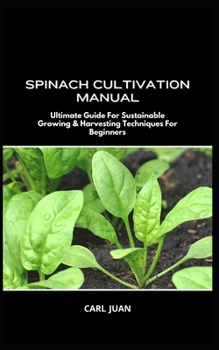Spinach Cultivation Manual: Ultimate Guide For Sustainable Growing & Harvesting Techniques For Beginners
In this context, "spinach growing" refers to the practice of planting spinach in a garden, farm, or other appropriate setting for the production of leafy green vegetables. It entails planting spinach seeds or seedlings, providing them with the appropriate care, and enabling them to mature into edible plants. The following are the most important stages and factors in spinach cultivation:
1. Prepare the soil by adding compost or organic matter to boost its texture and nutrient content; spinach prefers slightly acidic to neutral soil.
2. Spinach can be planted either from seeds or seedlings. Spinach seeds can be planted outside or started indoors and then moved to a more permanent location. The seeds should be planted approximately half an inch deep and two to four inches apart.
3. Spinach does not do well in shade and need full sun. Make sure the plants get plenty of light; nevertheless, they can handle some shadow, particularly in warmer climates.
4. Maintain a steady moisture level in the soil without letting it become soggy. Spinach needs consistent moisture, but more so when conditions are dry. To avoid spreading disease, you should not water from above.
5. Applying a well-balanced fertilizer, often one high in nitrogen, is helpful for spinach plants. In order to ensure that you get edible leaves, it's important to follow the instructions on the fertilizer bottle and not over-fertilize.
6. Once spinach seedlings have developed a few genuine leaves, they should be thinned to the appropriate spacing. That way, the surviving plants won't be crowded out.
7. Pest and Disease Management Watch out for aphids and caterpillars when growing spinach. Also, keep an eye out for diseases like downy mildew and take preventative or corrective action as needed.
8. Spinach leaves are ready to be picked after they have reached the desired size, often four to six weeks after sowing. Leaves can be picked individually, or the entire plant can be snipped about an inch or so above the soil. Consistent reaping encourages further development.
9. Consider planting spinach in succession every two to three weeks throughout the growing season to ensure a steady supply.
10. Cool weather is ideal for growing spinach. In hot summer temperatures, it is more likely to bolt (go to seed) than to flourish. You may also plant it indoors or in a greenhouse to lengthen the growth season.
Simply put, the term "spinach growing" refers to the entire process of growing spinach. A healthy crop of fresh spinach leaves for salads, cooking, and juicing is yours for the taking if you follow these instructions.
1. Prepare the soil by adding compost or organic matter to boost its texture and nutrient content; spinach prefers slightly acidic to neutral soil.
2. Spinach can be planted either from seeds or seedlings. Spinach seeds can be planted outside or started indoors and then moved to a more permanent location. The seeds should be planted approximately half an inch deep and two to four inches apart.
3. Spinach does not do well in shade and need full sun. Make sure the plants get plenty of light; nevertheless, they can handle some shadow, particularly in warmer climates.
4. Maintain a steady moisture level in the soil without letting it become soggy. Spinach needs consistent moisture, but more so when conditions are dry. To avoid spreading disease, you should not water from above.
5. Applying a well-balanced fertilizer, often one high in nitrogen, is helpful for spinach plants. In order to ensure that you get edible leaves, it's important to follow the instructions on the fertilizer bottle and not over-fertilize.
6. Once spinach seedlings have developed a few genuine leaves, they should be thinned to the appropriate spacing. That way, the surviving plants won't be crowded out.
7. Pest and Disease Management Watch out for aphids and caterpillars when growing spinach. Also, keep an eye out for diseases like downy mildew and take preventative or corrective action as needed.
8. Spinach leaves are ready to be picked after they have reached the desired size, often four to six weeks after sowing. Leaves can be picked individually, or the entire plant can be snipped about an inch or so above the soil. Consistent reaping encourages further development.
9. Consider planting spinach in succession every two to three weeks throughout the growing season to ensure a steady supply.
10. Cool weather is ideal for growing spinach. In hot summer temperatures, it is more likely to bolt (go to seed) than to flourish. You may also plant it indoors or in a greenhouse to lengthen the growth season.
Simply put, the term "spinach growing" refers to the entire process of growing spinach. A healthy crop of fresh spinach leaves for salads, cooking, and juicing is yours for the taking if you follow these instructions.
Format:Paperback
Language:English
ISBN:B0CS2P1CHX
ISBN13:9798875658051
Release Date:January 2024
Publisher:Independently Published
Length:58 Pages
Weight:0.15 lbs.
Dimensions:0.1" x 5.0" x 8.0"
Customer Reviews
0 rating





